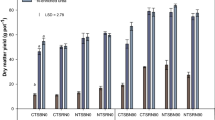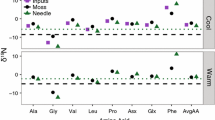Abstract
The possibility of using natural abundance techniques to determine N transformations and flows after deposition of cattle dung has been examined. These preliminary results showed that δ15N in dung was greater than in plants growing in association with particular pats. This, and other observational information, indicated that dung pats of different ages were being examined. There were significant variations in plant δ15N signatures within and between species grown in association and away from the dung. It was probable that variation in plant δ15N was brought about by changes in soil mineral N pools after transfer of N derived from the dung. This resulted in different δ15N signatures in Trifolium repens (because of changes in N utilization from soil or atmospheric pools), in Lolium perenne (because of changes in δ15N in soil mineral N), but not in Ranunculus repens (because the majority of active roots were outside the range of immediate influence of the deposited dung). The differences in δ15N allowed the development of hypotheses for changes in soil N pools and the acquisition of N by plants from soil, dung or atmospheric sources.
Similar content being viewed by others
References
Bremer E, Gehlen H, Swerhone G D W and van Kessel C 1993 Assessment of reference crops for the quantification of N2 fixation using natural and enriched levels of N-15 abundance. Soil Biol. Biochem. 25, 1197–1202.
Delwiche C C and Steyn P L 1970 Nitrogen isotope fractionation in soils and microbial reactions. Environ. Sci. Technol. 21, 929–935.
Harley J L and Harley E L 1987 A check list of mycorrhiza in the British flora. New Phytol. (Suppl.) 105, 1–102.
Haynes R J 1986 Mineral Nitrogen in the Plant Soil System. pp 108–109. Academic Press Inc., New York, USA.
Haynes R J and Williams P H 1993 Nutrient cycling and soil fertility in the grazed pasture ecosystem. Adv. Agron. 49, 119–199.
Hutton J B, Jury K E and Davies E B 1965 Studies in the nutritive value of New Zealand dairy pastures. 4. The intake and utilization of magnesium in pasture herbage by lactating dairy cattle. N.Z. J. Agric. Res. 8, 479–496.
Jarvis S C, Hatch D J and Roberts D H 1989 The effects of grassland management on nitrogen losses from grazed swards through ammonia volatilization: the relationship to excretal returns from cattle. J. Agric. Sci., Camb. 112, 205–216.
Kirchmann H 1985 Losses, plant uptake and utilization of manure nitrogen during a production cycle. Acta Agric. Scand. (Suppl.) 24, 1–72.
Mariotti A 1983 Atmospheric nitrogen is a reliable standard for natural 15N abundance measurements. Nature 303, 685–687.
Marks S, Clay K and Cheplick G P 1991 Effects of fungal endophytes on competition grasses in Festuca arundinaceae and Lolium perenne. J. Appl. Ecol. 28, 194–204.
Marsh R and Campling R C 1970 Fouling of pastures by dung. Herb. Abstr. 40, 123–129.
Nesheim L and Boller B C 1991 Nitrogen fixation by white clover when competing with grasses at moderately low temperatures. Plant and Soil 133, 47–56.
Petersen R G, Lucas H L and Woodhouse W W 1956 The distribution of excreta by freely grazing cattle and its influence on pasture fertility. I. Excretal density. Agron. J. 49, 440–444.
Shearer G and Kohl D H 1986 N2 fixation in field settings: Estimations based upon natural 15N abundance. Aust. J. Plant Physiol. 13, 699–756.
Sommer S G and Olesen J E 1991 Effects of dry matter content and temperature on ammonia loss from surface-applied cattle slurry. J. Environ. Qual. 20, 679–683.
Sørensen P, Jensen E S and Nielsen N E 1994 Labelling of animal manure nitrogen with 15N Plant and Soil 162, 31–38.
Steele K W and Daniel R M 1978 Fractionation of nitrogen isotopes by animals: a further complication to the use of variations in the natural abundance of 15N for tracer studies. J. Agric. Sci., Camb. 90, 7–9.
Sutherland R A, van Kessel C, Farrell R E and Pennock D J 1993 Landscape-scale variations in plant and soil nitrogen-15 natural abundance. Soil Sci. Soc. Am. J. 57 169–178.
Tiessen H, Karamanos R E, Stewart J W B and Selles F 1984 Natural nitrogen-15 abundance as an indicator of soil organic matter transformations in native and cultivated soils. Soil Sci. Soc. Am. J. 48, 312–315.
Turkington R, Klein E and Chanway C P 1993 Interactive effects of nutrients and disturbance—an experimental test of plant strategy theory. Ecology 74, 863–875.
Turner G L, Bergersen F J and Tantala H 1983 Natural enrichment of 15N during decomposition of plant material in soil. Soil Biol. Biochem. 15, 495–497.
Van Kessel C, Farrell R E, Roskoski J P and Keane K M 1994 Recycling of the naturally occurring 15N in an established stand of Leucaena leucocephala. Soil Biol. Biochem. 26, 757–762.
Author information
Authors and Affiliations
Rights and permissions
About this article
Cite this article
Kerley, S.J., Jarvis, S.C. Preliminary studies of the impact of excreted N on cycling and uptake of N in pasture systems using natural abundance stable isotopic discrimination. Plant Soil 178, 287–294 (1996). https://doi.org/10.1007/BF00011595
Received:
Accepted:
Issue Date:
DOI: https://doi.org/10.1007/BF00011595




